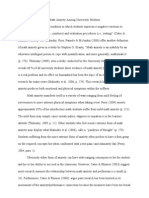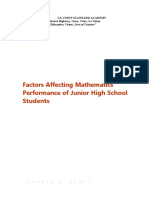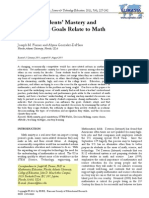Sex Differences in Mathematical Reasoning Ability: More Facts
Sex Differences in Mathematical Reasoning Ability: More Facts
Uploaded by
Anecito Cruzada TanzonCopyright:
Available Formats
Sex Differences in Mathematical Reasoning Ability: More Facts
Sex Differences in Mathematical Reasoning Ability: More Facts
Uploaded by
Anecito Cruzada TanzonOriginal Description:
Original Title
Copyright
Available Formats
Share this document
Did you find this document useful?
Is this content inappropriate?
Copyright:
Available Formats
Sex Differences in Mathematical Reasoning Ability: More Facts
Sex Differences in Mathematical Reasoning Ability: More Facts
Uploaded by
Anecito Cruzada TanzonCopyright:
Available Formats
Sex differences in mathematical reasoning ability: more facts
1. CP Benbow,
2. JC Stanley
ABSTRACT
Almost 40,000 selected seventh-grade students from the Middle Atlantic region of the United States took the College
Board Scholastic Aptitude Test as part of the Johns Hopkins regional talent search in 1980, 1981, and 1982. A separate
nationwide talent search was conducted in which any student under age 13 who was willing to take the test was eligible.
The results obtained by both procedures establish that by age 13 a large sex difference in mathematical reasoning ability
exists and that it is especially pronounced at the high end of the distribution: among students who scored greater than or
equal to 700, boys outnumbered girls 13 to 1. Some hypothesized explanations of such differences were not supported by
the data.
http://cas.uchicago.edu/workshops/cognition/files/2013/01/Ganley-Vasilyeva-2011-JADP.pdf
http://www.sciencemag.org/content/222/4627/1029.abstract
http://www.iea.nl/fileadmin/user_upload/IRC/IRC_2008/Papers/IRC2008_Kiamanesh_Mahdavi-
Hezaveh.pdf
https://my.vanderbilt.edu/smpy/files/2013/01/SexDiffs.pdf
http://www.usca.edu/essays/vol212007/adeleke.pdf
Stereotypes about Gender and Mathematics
Mathematics and science are stereotyped as male domains (Fennema & Sherman,
1977; Hyde, Fennema, Ryan, Frost, & Hopp, 1990b, Nosek, et al, 2009). Stereotypes about
female inferiority in mathematics are prominent among children and adolescents, parents,
and teachers. Although children may view boys and girls as being equal in mathematical
ability, they nonetheless view adult men as being better at mathematics than adult women
(Steele, 2003). Implicit attitudes that link males and mathematics have been demonstrated
repeatedly in studies of college students (e.g., Kiefer & Sekaquaptewa, 2007; Nosek, Banaji,
& Greenwald, 2002).
Parents believe that their sons' mathematical ability is higher than their daughters'. In one
study, fathers estimated their sons' mathematical IQ at 110 on average, and their
daughters' at 98; mothers estimated 110 for sons and 104 for daughters (Furnham et al.,
2002; see also Frome & Eccles, 1998). Teachers, too, tend to stereotype mathematics as a
male domain. In particular, they overrate boys' ability relative to girls' (Li, 1999; but
see Helwig, Anderson, & Tindal, 2001).
These stereotypes are of concern for several reasons. First, in the language of cognitive
social learning theory, stereotypes can influence competency beliefs or self-efficacy;
correlational research does indeed show that parents' and teachers' stereotypes about
gender and mathematics predict children's perceptions of their own abilities, even with
actual mathematics performance controlled (Bouchey & Harter, 2005; Frome & Eccles,
1998; Keller, 2001; Tiedemann, 2000). Competency beliefs are important because of their
profound effect on individuals' selection of activities and environments (Bandura,
1997; Bussey & Bandura, 1999). According to an earlier meta-analysis, girls report lower
mathematics competence than boys do, although the difference is not large (d = +.16, Hyde
et al., 1990b). In recent studies, elementary-school boys still report significantly higher
mathematics competency beliefs than girls do (Else-Quest, Hyde, & Linn, 2010; Fredrick &
Eccles, 2002; Lindberg, Hyde, & Hirsch, 2008; Watt, 2004).
A second concern is that stereotypes can have a deleterious effect on actual performance.
Stereotype threat effects (Steele, 1997; Steele & Aronson, 1995) have been found for women
in mathematics. In the standard paradigm, half the participants (talented college students)
are told that the math test they are about to take typically shows gender differences (threat
condition), and the other half is told that the math test is gender fair and does not show
gender differences (control). Studies find that college women underperform compared with
men in the threat condition but perform equal to men in the control condition, indicating
that priming for gender differences in mathematics indeed impairs girls' math performance
(e.g.,Ben-Zeev, Fein, & Inzlicht, 2005; Cadinu, Maass, Rosabianca, & Kiesner, 2005;Johns,
Schmader, & Martens, 2005; Quinn & Spencer, 2001; Spencer, Steele, & Quinn, 1999).
Stereotype threat effects have been found in children as early as kindergarten (Ambady,
Shih, Kim, & Pittinsky, 2001). Other research, measuring implicit stereotypes about gender
and math, has found that these implicit stereotypes predict performance in a calculus course
(Kiefer & Sekaquaptewa, 2007).
Stereotypes play a role in policy decisions as well as personal decision-making. For example,
schools and states may base decisions to offer single-sex mathematics classes on the belief
that these gender differences exist (Arms, 2007).
Gender and Mathematics Performance
The stereotypes about female inferiority in mathematics stand in distinct contrast to the
scientific data on actual performance. A 1990 meta-analysis found an effect size ofd = 0.15,
males scoring higher, for gender differences in mathematics performance averaged over all
samples; however, in samples of the general population (i.e. national samples, classrooms
as opposed to exceptionally precocious or low ability samples), females scored higher but by
a negligible amount (d = 0.05; Hyde, Fennema, & Lamon, 1990a). Hedges and Nowell
(1995), using data sets representing large probability samples of American adolescents,
found d = 0.03 to 0.26 across the different data sets. Moreover, girls earn better grades in
mathematics courses than boys through the end of high school (Dwyer & Johnson,
1997; Kenney-Benson et al., 2006; Kimball, 1989). In short, previous research showed that
gender differences in mathematics performance were very small and, depending on the
sample and outcome measure, sometimes favored boys and sometimes favored girls.
Several features of the 1990 meta-analysis (Hyde et al., 1990a) warrant more detailed
description. Using computerized literature searches, the researchers identified 100 useable
studies, which yielded 254 independent effect sizes representing the testing of more than 3
million persons. One key moderator analysis examined the magnitude of gender differences
as a function of age and cognitive level of the test (computation was considered the lowest
level, understanding of concepts was considered intermediate, and complex problem-
solving was considered the highest level). Girls performed better than boys at computation
in elementary school and middle school but the differences were small (d = 0.20 and
0.22, respectively) and there was no gender difference in high school. There was no gender
difference in understanding of mathematical concepts at any age. For complex problem
solving, there was no gender difference in elementary or middle school, but a gender
difference favoring males emerged in high school (d = 0.29). This last gender difference,
although small, is of concern because complex problem solving is crucial for STEM careers.
A second moderator analysis examined the magnitude of gender differences in mathematics
performance as a function of the ethnicity of the sample (Hyde et al., 1990a). The striking
finding was that the small gender difference favoring males was found for Whites (d = 0.13),
but not for Blacks (0.02) or Latinos (0.00).
Depth of Knowledge
Traditionally, researchers maintained that girls might do as well as, or even better than boys
on tests of computation, which require relatively simple cognitive processes (e.g., Anastasi,
1958). These same researchers concluded that male superiority emerged for tests requiring
more advanced cognitive processing, such as complex problem solving. The 1990 meta-
analysis by Hyde and colleagues provided some support for these ideas, although the gender
difference in complex problem solving did not appear until the high school years and was
not large even then.
Current mathematics education researchers conceptualize this issue of complexity of
cognitive processes as a question of item demand and the depth of knowledge required to
solve a particular problem. Webb (1999) developed a 4-level Depth of Knowledge
framework to identify the cognitive difficulty of mathematics items on standardized
assessments. In this framework, Level 1 (Recall) includes the recall of information such as
facts or definitions, as well as performing simple algorithms. Level 2 (Skill/Concept)
includes items that require students to make decisions about how to approach a problem.
These items typically ask students to classify, organize, estimate, or compare information.
Level 3 (Strategic Thinking) includes complex and abstract cognitive demands that require
students to reason, plan, and use evidence. Level 4 (Extended Thinking) requires complex
reasoning, planning, developing, and thinking over an extended period of time. Items at
Level 4 require students to connect ideas within the content area or among content areas as
they develop one problem-solving approach from many alternatives. This depth of
knowledge framework was used to rate the cognitive demands of the tests that assess
mathematics performance in the studies reviewed here.
New Trends
Cultural shifts have occurred since the 1980s that call for the reexamination of gender
differences in mathematics. In the 1980s, a prominent explanation of male superiority in
complex problem solving beginning in high school was gender differences in course choice
(Meece, Eccles-Parsons, et al, 1982). Girls were less likely than boys to take advanced
mathematics courses and advanced science courses. Because mathematical problem solving
is an important component of chemistry and physics courses, students may learn those
skills in science courses as much as in mathematics courses. Today, however, the gender gap
in course taking has disappeared in all areas except physics. For the high school graduating
class of 2005, 7.7% of boys and 7.8% of girls took calculus; 57.8% of girls and 50.6% of boys
took chemistry; and 32.8% of girls and 36.8% of boys took physics (NSF, 2008c). Insofar as
courses taken by students influence their mathematics performance, we would expect that
the gender difference in complex problem solving in high school would have narrowed.
In addition, cross-national data show that the gender gap in mathematics performance
narrows or even reverses in societies with more gender equality (e.g., Sweden and Iceland),
compared with those with more gender inequality (e.g., Turkey) (Else-Quest, Hyde, & Linn,
2010; Guiso, Monte, Sapienza, & Zingales, 2008). Insofar as the United States has moved
toward gender equality over the past 30 to 40 years, the gender gap in mathematics
performance should have narrowed.
Findings from a recent analysis of data from state assessments of mathematics performance
provide evidence that the gender gap in mathematics performance in the U.S. has indeed
diminished or even vanished (Hyde, Lindberg, Linn, Ellis, & Williams, 2008). Those data
had several limitations and raised some questions that deserve analysis in a larger study.
First, they were based just on tests administered by the states to satisfy the requirements of
No Child Left Behind Legislation. Items tapping Levels 3 or 4 depth of knowledge were
notably absent. Second, the data were derived only from students in grades 2 through 11;
trends in gender differences beyond grade 11 (age 17) could therefore not be assessed. Third,
the distributions of male and female performance were available for only part of the sample.
The available results raised intriguing questions about gender differences in complex
problem solving since in some subgroups females outperformed males at the high end of the
distribution.
Abstract
Several hundred thousand intellectually talented 12-to 13-year-olds have been tested nationwide over the past 16
years with the mathematics and verbal sections of the Scholastic Aptitude Test (SAT). Although no sex differences in
verbal ability have been found, there have been consistent sex differences favoring males in mathematical reasoning
ability, as measured by the mathematics section of the SAT (SAT-M). These differences are most pronounced at the
highest levels of mathematical reasoning, they are stable over time, and they are observed in other countries as well.
The sex difference in mathematical reasoning ability can predict subsequent sex differences in achievement in
mathematics and science and is therefore of practical importance. To date a primarily environmental explanation for
the difference in ability has not received support from the numerous studies conducted over many years by the staff
of Study of Mathematically Precocious Youth (SMPY) and others. We have studied some of the classical
environmental hypotheses: attitudes toward mathematics, perceived usefulness of mathematics, confidence,
expectations/ encouragement from parents and others, sex-typing, and differential course-taking. In addition, several
physiological correlates of extremely high mathematical reasoning ability have been identified (left-handedness,
allergies, myopia, and perhaps bilateral representation of cognitive functions and prenatal hormonal exposure). It is
therefore proposed that the sex difference in SAT-M scores among intellectually talented students, which may be
related to greater male variability, results from both environmental and biological factors.
http://journals.cambridge.org/action/displayAbstract?fromPage=online&aid=6723388
Most studies show that, on average, girls do better in school than boys. Girls get higher
grades and complete high school at a higher rate compared to boys (Jacobs, 2002).
Standardized achievement tests also show that females are better at spelling and
perform better on tests of literacy, writing, and general knowledge (National Center for
Education Statistics, 2003). An international aptitude test administered to fourth
graders in 35 countries, for example, showed that females outscored males on reading
literacy in every country. Although there were no differences between boys and girls in
fourth grade on mathematics, boys began to perform better than girls on science tests
in fourth grade (International Association for the Evaluation of Education Achievement,
n.d.). Girls continue to exhibit higher verbal ability throughout high school, but they
begin to lose ground to boys after fourth grade on tests of both mathematical and
science ability. These gender differences in math and science achievement have
implications for girls future careers and have been a source of concern for educators
everywhere.
During the past decade, there has been a concerted effort to find out why there is a
shortage of women in the science, math, engineering, and technical fields (AAUW,
1992). In 1995, 22% of Americas scientists and engineers were women, compared to
half of the social scientists. Women who do pursue careers in science, engineering, and
mathematics most often choose fields in the biological sciences, where they represent
40% of the workforce, with smaller percentages found in mathematics or computer
science (33%), the physical sciences (22%), and engineering (9%) (National Science
Board, 1998).
Part of the explanation can be traced to gender differences in the cognitive abilities of
middle-school students. In late elementary school, females outperform males on
several verbal skills tasks: verbal reasoning, verbal fluency, comprehension, and
understanding logical relations (Hedges & Nowell, 1995). Males, on the other hand,
outperform females on spatial skills tasks such as mental rotation, spatial perception,
and spatial visualization (Voyer, Voyer, & Bryden, 1995). Males also perform better on
mathematical achievement tests than females. However, gender differences do not
apply to all aspects of mathematical skill. Males and females do equally well in basic
math knowledge, and girls actually have better computational skills. Performance in
mathematical reasoning and geometry shows the greatest difference (Fennema,
Sowder, & Carpenter, 1999). Males also display greater confidence in their math skills,
which is a strong predictor of math performance (Casey, Nuttall, & Pezaris, 2001).
The poorer mathematical reasoning skills exhibited by many female adolescents have
several educational implications. Beginning at age 12, girls begin to like math and
science less and to like language arts and social studies more than do boys (Kahle &
Lakes, 2003; Sadker & Sadker, 1994). They also do not expect to do as well in these
subjects and attribute their failures to lack of ability (Eccles, Barber, Jozefowicz,
Malenchuk, & Vida, 1999). By high school, girls self-select out of higher-level,
academic-track math and science courses, such as calculus and chemistry. One of the
long-term consequences of these choices is that girls lack the prerequisite high school
math and science courses necessary to pursue certain majors in college (e.g.,
engineering, computer science). Consequently, the number of women who pursue
advanced degrees in these fields is significantly reduced (Halpern, 2004).
Some researchers, on the one hand, argue that the gender gap in mathematics is
biologically driven. Selected research shows that prenatal hormones circulating in the
brain encourage differential development in the hemispheres of male and female
fetuses (Berenbaum, Korman, & Leveroni, 1995). Others believe intelligence has its
roots in genetics (Plomin, 2000). There is evidence, however, that sociocultural factors
may influence girls attitudes toward math and science. For example, parents tend to
view math as more important for sons and language arts and social studies as more
important for daughters (Andre, Whigham, Hendrickson, & Chambers, 1999). Parents
are more likely to encourage their sons to take advanced high school courses in
chemistry, mathematics, and physics and have higher expectations for their success
(Wigfield, Battle, Keller, & Eccles, 2002).
Teacher characteristics and the classroom environment also have been identified as
contributors to this gender gap. Seventh and eighth graders attending math and
science camps identified a math or science teacher as a person who has made math,
science, or engineering interesting for them (Gilbert, 1996, p. 491). Unfortunately,
many females report being passed over in classroom discussions, not encouraged by
the teacher, and made to feel stupid (Sadker & Sadker, 1994). Classroom environments
can be made to feel more girl-friendly by incorporating
Low levels of competition, public drill, and practice
High levels of teacher attention
Hands-on activities
Female role models
Same-sex cooperative learning communities
Nonsexist books and materials (Evans, Whigham, & Wang, 1995)
Fortunately, sex differences in mathematical reasoning have begun to decline, and
females enrollments are up in math and science courses (Campbell, Hombo, & Mazzeo,
2000; Freeman, 2004). Programs designed to interest girls in math and science and
that demonstrate how this knowledge will allow them to help others appear to be
working.
So, why are males superior at math? Let's be more specific, since the reality is a bit
mixed:
In late elementary school, females outperform males on several verbal skills tasks:
verbal reasoning, verbal fluency, comprehension, and understanding logical
relations (Hedges & Nowell, 1995). Males, on the other hand, outperform females on
spatial skills tasks such as mental rotation, spatial perception, and spatial
visualization (Voyer, Voyer, & Bryden, 1995). Males also perform better on
mathematical achievement tests than females. However, gender differences do not
apply to all aspects of mathematical skill. Males and females do equally well in basic
math knowledge, and girls actually have better computational [arithmetic _ ed.]
skills. Performance in mathematical reasoning and geometry shows the
greatest difference (Fennema, Sowder, & Carpenter, 1999). _Education
In fact, recent research shows that males begin to take a qualitatively different approach
to math thinking from an early age:
In a University of Missouri study, girls and boys started grade school with different
approaches to solving arithmetic problems, with girls favoring a slow and accurate
approach and boys a faster but more error prone approach. Girls approach gave them
an early advantage, but by the end of sixth grade boys had surpassed the girls....
Developing mathematical skill may be part practice makes perfect and part perfect
makes practice, Bailey said. Attempting more answers from memory gives risk-takers
more practice, which may eventually lead to improvements in accuracy. It also is
possible that children who are skilled at certain strategies are more likely to use them
and therefore acquire more practice. _MU News
The greater boldness exhibited by boys in math class is likely a testosterone effect, which
is exhibited in so many other behavioural differences between males and females in
childhood, adolescence, and early to middle adulthood.
The male superiority in spacial skills tasks and advanced math reasoning is likely to
derive from far more subtle changes in the brain than those that lead to greater male
boldness. But those more subtle changes are also largely due to testosterone effect.
These brain changes occur over time -- slowly in childhood, and at a faster rate in
adolescence. All levels of brain activity -- from gene expression to physiological
parameters to brain structure to cognitive function -- are involved.
Recent feminist-inspired studies which compare male : female math skills in childhood
or very early in adolescence are unable to detect the most significant brain
transformations, and are thus likely to fail to detect very real differences. Likewise,
studies which focus upon comparisons of basic arithmetic skills, fail to detect the male
advantages in spatial skills and in advanced mathematical reasoning.
Fortunately, better tools for detecting brain activity and differences at all levels -- from
gene expression to fine brain structure to the neurological correlates of cognition -- are
all in development.
A fascinating new brain imager which combines MEG (magnetoencephalography) with
MRI (magnetic resonance imaging) will allow an unprecedented degree of simultaneous
spatial and temporal imaging of brain structure and activity.
Functional brain imaging has already developed to the point where it can be used as an
objective, culture-free test for cognitive function and speed. It is only a matter of time
before such crude objective measures of cognition can be fine-tuned to look at distinct
types of cognition, including mathematical and spatial reasoning.
When it comes to brain, cognition, and behaviour, hormones have consequences. The
sooner human academics can grow beyond their political correctness to look at these
issues objectively and honestly, the sooner we can find ways for all of us to move ahead.
You might also like
- (Download PDF) The Psychology of Sex and Gender 2Nd Edition Jennifer K Bosson Online Ebook All Chapter PDFDocument31 pages(Download PDF) The Psychology of Sex and Gender 2Nd Edition Jennifer K Bosson Online Ebook All Chapter PDFvanda.crawford256100% (22)
- Personality Psychology: Domains of Knowledge About Human Nature 2nd CDN Ed. Edition Randy J. Larsen Full Chapter Instant DownloadDocument44 pagesPersonality Psychology: Domains of Knowledge About Human Nature 2nd CDN Ed. Edition Randy J. Larsen Full Chapter Instant Downloadmoemekhupno51100% (1)
- FULL Download Ebook PDF Introduction To Psychology 3rd Edition by Charles Stangor PDF EbookDocument42 pagesFULL Download Ebook PDF Introduction To Psychology 3rd Edition by Charles Stangor PDF Ebookfaith.bratcher185100% (47)
- Students' Beliefs and Attitudes Concerning Mathematics and Their Effect On Mathematical AbilityDocument10 pagesStudents' Beliefs and Attitudes Concerning Mathematics and Their Effect On Mathematical AbilityMa'am KC Lat PerezNo ratings yet
- The War Against BoysDocument15 pagesThe War Against BoyslolidelachicaNo ratings yet
- Gifted Child Quarterly 2008 Preckel 146 59Document14 pagesGifted Child Quarterly 2008 Preckel 146 59Grace JustinNo ratings yet
- Ajsms 2 4 348 355Document8 pagesAjsms 2 4 348 355Akolgo PaulinaNo ratings yet
- An Empirical Analysis of The Gender Gap in Mathematics: Rfryer@fas - Harvard.eduDocument48 pagesAn Empirical Analysis of The Gender Gap in Mathematics: Rfryer@fas - Harvard.edudsafasdfsdafaNo ratings yet
- Gender Issues in Mathematics: An Ontario Perspective: Journal of Teaching and Learning, 2012, Vol. 8 No. 1Document14 pagesGender Issues in Mathematics: An Ontario Perspective: Journal of Teaching and Learning, 2012, Vol. 8 No. 1vinoelnino10No ratings yet
- Sra02 FullpaperDocument14 pagesSra02 FullpaperjojopebblesNo ratings yet
- Math Anxiety Among University StudentsDocument6 pagesMath Anxiety Among University StudentsDanny DavisNo ratings yet
- This Content Downloaded From 103.133.218.70 On Sat, 19 Dec 2020 12:50:05 UTCDocument27 pagesThis Content Downloaded From 103.133.218.70 On Sat, 19 Dec 2020 12:50:05 UTCPuran Gurung LogophileNo ratings yet
- Causes of Negative Attitudes Toward Mathematics in Middle School StudentsDocument19 pagesCauses of Negative Attitudes Toward Mathematics in Middle School Studentsapi-3820126100% (8)
- Math Anxiety 2003Document40 pagesMath Anxiety 2003Andrea HalimNo ratings yet
- Janet Hyde Sex and Cognition IncompleteDocument3 pagesJanet Hyde Sex and Cognition IncompleteJorge De Lama VargasNo ratings yet
- Curr 345 Summary of ResearchDocument6 pagesCurr 345 Summary of Researchapi-268934937No ratings yet
- Journal Computer ScienceDocument24 pagesJournal Computer ScienceAng RonaldNo ratings yet
- Separting Implicit Gender Stereotypes Steffens-JelenecDocument12 pagesSeparting Implicit Gender Stereotypes Steffens-JelenecApolo CastañedaNo ratings yet
- Modelo de Artículo ApaDocument31 pagesModelo de Artículo ApaHugo González AguilarNo ratings yet
- Final ResearchDocument21 pagesFinal ResearchJely Diansen VargasNo ratings yet
- Exploring Adolescent Motivations For Pursuing Maths-Related CareersDocument10 pagesExploring Adolescent Motivations For Pursuing Maths-Related CareerssachinthaNo ratings yet
- The Study of The Factors Influencing Students Attitudes Towards Learning Mathematics in The Junior Secondary SchoolDocument21 pagesThe Study of The Factors Influencing Students Attitudes Towards Learning Mathematics in The Junior Secondary Schoolh_cenoNo ratings yet
- Secondary Students Attitudes Towards MathematicsDocument13 pagesSecondary Students Attitudes Towards MathematicsAUBREY ESCOBALNo ratings yet
- Gender Gap in Science, Technology, Engineering, and Mathematics (STEM) : Current Knowledge, Implications For Practice, Policy, and Future DirectionsDocument22 pagesGender Gap in Science, Technology, Engineering, and Mathematics (STEM) : Current Knowledge, Implications For Practice, Policy, and Future DirectionsBarguan IacobNo ratings yet
- QuinnDocument18 pagesQuinnvannesseNo ratings yet
- UNIT 1 - A Research NoteDocument8 pagesUNIT 1 - A Research NoteCOSTELNo ratings yet
- Investigating The Relationship Between Science Self-EfficacyDocument8 pagesInvestigating The Relationship Between Science Self-EfficacyJeffrey MasiconNo ratings yet
- 2009newcombe PDFDocument13 pages2009newcombe PDFAneeza LiaqatNo ratings yet
- Watt ERE2006Document18 pagesWatt ERE2006JordanNo ratings yet
- Mathematics and Math AnxietyDocument15 pagesMathematics and Math AnxietyAnonymous M5fGNlruNo ratings yet
- Chinese Children Excel On Novel Mathematics Problems Even Before Elementary SchoolDocument5 pagesChinese Children Excel On Novel Mathematics Problems Even Before Elementary SchoolBuried_ChildNo ratings yet
- Sda - Group 5 Final ProjectDocument38 pagesSda - Group 5 Final Projectapi-355616688No ratings yet
- Mathematics Anxiety's Impact On Grade 11 General Mathematics PerformanceDocument6 pagesMathematics Anxiety's Impact On Grade 11 General Mathematics PerformanceJournal of Interdisciplinary PerspectivesNo ratings yet
- EJ1357687Document11 pagesEJ1357687livia eunikeNo ratings yet
- Anxiety, Working Memory, Gender, and Math PerformanceDocument16 pagesAnxiety, Working Memory, Gender, and Math PerformanceallanyzbNo ratings yet
- Kane & Mertz - Debunking Myths About Gender and Mathematics PerformanceDocument12 pagesKane & Mertz - Debunking Myths About Gender and Mathematics Performancemorganlo_at_ubNo ratings yet
- Mathematics Anxiety in Secondary Students in England: Independent Maths LD/Dyscalculia Consultant, Ledbury, UKDocument8 pagesMathematics Anxiety in Secondary Students in England: Independent Maths LD/Dyscalculia Consultant, Ledbury, UK贼贼JacksonNo ratings yet
- Relationships Between Attitudes and Performance in Young Children 'S MathematicsDocument20 pagesRelationships Between Attitudes and Performance in Young Children 'S MathematicsSteve MaiwatNo ratings yet
- 2009 - Identifying Early Numeracy Indicators For Kindergarten and First-Grade StudentsDocument9 pages2009 - Identifying Early Numeracy Indicators For Kindergarten and First-Grade StudentsDanilka Castro CañizaresNo ratings yet
- Some Variables in Relation To Students'Anxiety in Learning StatisticsDocument7 pagesSome Variables in Relation To Students'Anxiety in Learning StatisticstosuteaNo ratings yet
- Confidence and PerformanceDocument13 pagesConfidence and PerformanceChristine PearlNo ratings yet
- RRLDocument17 pagesRRLCleizel Mei FlorendoNo ratings yet
- Detecting Gender Related DIF Using Logistic Regression and Mantel-Haenszel ApproachesDocument8 pagesDetecting Gender Related DIF Using Logistic Regression and Mantel-Haenszel ApproachesMuhammed KaraNo ratings yet
- Webb RM 2001 TopDocument22 pagesWebb RM 2001 TopUnzip My GenesNo ratings yet
- Development of Understanding and Self-Confidence in Mathematics Grades 5-8Document8 pagesDevelopment of Understanding and Self-Confidence in Mathematics Grades 5-8Ronaldo Nabua IINo ratings yet
- A Review of Litterature Gender Differences in Mathematical Problem Solving PatternDocument17 pagesA Review of Litterature Gender Differences in Mathematical Problem Solving PatternZaidComunicationNo ratings yet
- An Example of A Literature Review in Research On Math AnxietyDocument11 pagesAn Example of A Literature Review in Research On Math Anxietyfvgh9eptNo ratings yet
- Kawakami Et Al JESP 2008Document8 pagesKawakami Et Al JESP 2008mdayaz123No ratings yet
- Boys and Girls Educational Choices in Secondary EducationDocument21 pagesBoys and Girls Educational Choices in Secondary EducationJúlia Araújo MendesNo ratings yet
- Are We Wasting Our Children's Time by Giving Them More Homework?Document31 pagesAre We Wasting Our Children's Time by Giving Them More Homework?lingleyNo ratings yet
- Identifying Factors Affecting The Mathematics Achievement of Students For Better Instructional DesignDocument17 pagesIdentifying Factors Affecting The Mathematics Achievement of Students For Better Instructional DesignNur Nadiah100% (1)
- Mental Rotation Test Performance of Chinese Male and Female University StudentsDocument6 pagesMental Rotation Test Performance of Chinese Male and Female University StudentsTavo VegaNo ratings yet
- Ganley 2014Document17 pagesGanley 2014Hardiyanto HardiyantoNo ratings yet
- Factors Affecting Mathematics Performance of Junior High School Students 5938 (2) 2222Document15 pagesFactors Affecting Mathematics Performance of Junior High School Students 5938 (2) 2222James LabarintoNo ratings yet
- Psychological Bulletin: A Meta-Analysis of The Relation Between Math Anxiety and Math AchievementDocument106 pagesPsychological Bulletin: A Meta-Analysis of The Relation Between Math Anxiety and Math AchievementJordanNo ratings yet
- Gender Differences in Problem Solving AbilitiesDocument8 pagesGender Differences in Problem Solving AbilitiesKhushi BajajNo ratings yet
- Math Anxiety - BicolDocument10 pagesMath Anxiety - BicolCharmaine CastroNo ratings yet
- How Do Students' Mastery and Performance Goals Relate To Math Anxiety?Document16 pagesHow Do Students' Mastery and Performance Goals Relate To Math Anxiety?Nursyamsi Asy-syirbaniNo ratings yet
- Herges 2017 Motivation and Achievement of Middle School Mathematics StudentsDocument24 pagesHerges 2017 Motivation and Achievement of Middle School Mathematics StudentsCristhian AndresNo ratings yet
- The Effects of Math Anxiety On Post-Secondary Developmental Students As Related To Achievement, Gender, and AgeDocument5 pagesThe Effects of Math Anxiety On Post-Secondary Developmental Students As Related To Achievement, Gender, and AgeLaili Anisatu CMNo ratings yet
- Dyscalculia (Math)Document14 pagesDyscalculia (Math)David Montiel RamirezNo ratings yet
- Playful Testing: Designing a Formative Assessment Game for Data ScienceFrom EverandPlayful Testing: Designing a Formative Assessment Game for Data ScienceNo ratings yet
- Transforming Truancy: Exploring Factors and Strategies That Impact Truancy Among YouthFrom EverandTransforming Truancy: Exploring Factors and Strategies That Impact Truancy Among YouthNo ratings yet
- Testing Student Learning, Evaluating Teaching EffectivenessFrom EverandTesting Student Learning, Evaluating Teaching EffectivenessNo ratings yet
- Table of Specification Mathematics 7: Prepared By: Anecito TanzonDocument1 pageTable of Specification Mathematics 7: Prepared By: Anecito TanzonAnecito Cruzada TanzonNo ratings yet
- Question #1: Which Rule Explains Why These Triangles Are Congruent?Document4 pagesQuestion #1: Which Rule Explains Why These Triangles Are Congruent?Anecito Cruzada TanzonNo ratings yet
- Inverse Functions As LogarithmsDocument2 pagesInverse Functions As LogarithmsAnecito Cruzada TanzonNo ratings yet
- A Detailed Lesson PlanDocument4 pagesA Detailed Lesson PlanAnecito Cruzada TanzonNo ratings yet
- Exploring The Curriculum-FS4Document45 pagesExploring The Curriculum-FS4Lesleigh Ochavillo Manginsay84% (44)
- Frequencies: StatisticsDocument3 pagesFrequencies: StatisticsAnecito Cruzada TanzonNo ratings yet
- Anecito Detailed (MAthematics)Document1 pageAnecito Detailed (MAthematics)Anecito Cruzada TanzonNo ratings yet
- Archived Information: Strengthening Mathematics Skills at The Postsecondary Level: Literature Review and AnalysisDocument102 pagesArchived Information: Strengthening Mathematics Skills at The Postsecondary Level: Literature Review and AnalysisAnecito Cruzada TanzonNo ratings yet
- Tawog Day Care CenterDocument3 pagesTawog Day Care CenterAnecito Cruzada Tanzon100% (1)
- Cordelia Fine, Delusions of Gender: How Our Minds, Society, and Neurosexism Create DifferenceDocument4 pagesCordelia Fine, Delusions of Gender: How Our Minds, Society, and Neurosexism Create Difference156majamaNo ratings yet
- (Download PDF) The Psychology of Gender Vicki S Helgeson Online Ebook All Chapter PDFDocument42 pages(Download PDF) The Psychology of Gender Vicki S Helgeson Online Ebook All Chapter PDFvanda.crawford256100% (20)
- The Good of Children and SocietyDocument285 pagesThe Good of Children and SocietyHuzeyfe GültekinNo ratings yet
- Carryn SmitDocument36 pagesCarryn SmitGabriel ArnautuNo ratings yet
- Ebook Download (Ebook PDF) Children and Their Development, Fourth Canadian Edition 4th Edition All ChapterDocument43 pagesEbook Download (Ebook PDF) Children and Their Development, Fourth Canadian Edition 4th Edition All Chapterwitrunangal100% (7)
- Enene Ogbu EneneDocument45 pagesEnene Ogbu EneneMichael AdalikwuNo ratings yet
- Ren - A Deeper Look at Gender Difference in Multitasking: Gender-Specific Mechanism of Cognitive ControlDocument5 pagesRen - A Deeper Look at Gender Difference in Multitasking: Gender-Specific Mechanism of Cognitive ControlMarie-Lou MénétrierNo ratings yet
- Cognition and The BrainDocument12 pagesCognition and The BrainInterfan_allinNo ratings yet
- Personality DevelopmentDocument12 pagesPersonality DevelopmentGenevev ReyesNo ratings yet
- Sexuality Now Canadian 1st Edition Carroll Test BankDocument12 pagesSexuality Now Canadian 1st Edition Carroll Test Bankroryytpvk5g100% (32)
- Eagly - Wood.2013.nature Nurture DebatesDocument18 pagesEagly - Wood.2013.nature Nurture DebatesAmeena AimenNo ratings yet
- PSY6017 L7 Gender Development 2013 FallDocument34 pagesPSY6017 L7 Gender Development 2013 FallNick AviationNo ratings yet
- Accuracy and Confidence On The Interpersonal Perception TaskDocument16 pagesAccuracy and Confidence On The Interpersonal Perception TaskIva DraškovićNo ratings yet
- (Ebook PDF) (Ebook PDF) Children and Their Development, Fourth Canadian Edition 4th Edition All ChapterDocument32 pages(Ebook PDF) (Ebook PDF) Children and Their Development, Fourth Canadian Edition 4th Edition All Chapterbrondoridian100% (15)
- Pink and Blue: The Color of Gender: Child S Nervous System September 2008Document3 pagesPink and Blue: The Color of Gender: Child S Nervous System September 2008Ritika GuptaNo ratings yet
- Instant Ebooks Textbook (Ebook PDF) Exploring Child & Adolescent Development by Laura E. Berk Download All ChaptersDocument43 pagesInstant Ebooks Textbook (Ebook PDF) Exploring Child & Adolescent Development by Laura E. Berk Download All Chaptersishagesasoki100% (4)
- St. Paul University Surigao: The Emotional Response of Grade 12 Students of Towards Super Typhoon Rai/OdetteDocument60 pagesSt. Paul University Surigao: The Emotional Response of Grade 12 Students of Towards Super Typhoon Rai/OdetteKeanu FajardoNo ratings yet
- Curriculum OF Psychology BS/MS: (Revised 2013)Document226 pagesCurriculum OF Psychology BS/MS: (Revised 2013)Faiza Rasul0% (1)
- Gender and Helping Behavior PDFDocument26 pagesGender and Helping Behavior PDFElda FejzoNo ratings yet
- Full Download PDF of (Ebook PDF) Child Development: A Thematic Approach 6th Edition All ChapterDocument43 pagesFull Download PDF of (Ebook PDF) Child Development: A Thematic Approach 6th Edition All Chaptertimussullon6100% (16)
- Social Role TheoryDocument12 pagesSocial Role TheoryUmeshKumarNo ratings yet
- Unit 1Document5 pagesUnit 1Divyank SurumNo ratings yet
- Me Tarzan. You Jane. Basta!Document6 pagesMe Tarzan. You Jane. Basta!Dr. Celeste Fabrie100% (1)
- Cognitive Reflection and Decision MakingDocument52 pagesCognitive Reflection and Decision MakingBere GutiérrezNo ratings yet
- Eagly and Johannesen Schmidt 2001Document31 pagesEagly and Johannesen Schmidt 2001Grace GarnerNo ratings yet
- Schram Chapter 11 CRXDocument30 pagesSchram Chapter 11 CRXGlydel AbellaNo ratings yet


































































































